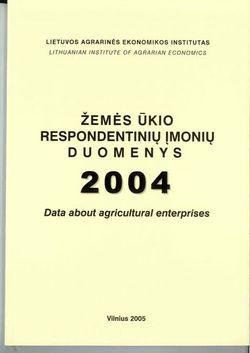
Statistical publications „Data about agricultural enterprises“ are published annually since 1996. The publication of 2005 is based on accountancy data of 2004 from 1335 family farms and 38 agricultural companies. Selected farms cover almost all districts, natural zones and reflect different farming conditions.
Lithuania is obliged to deliver data of 1000 farms to the EU Farm Accountancy Data Network (FADN). Lithuania is considered to be one FADN region, the threshold of the field of observation is 2 ESU (European Size Units). According to the Lithuanian legislation Lithuanian Institute of Agrarian Economics is assigned to be a Liaison Agency, Lithuanian Agricultural Advisory Service - Accountancy office.
In 2003 the first after regaining independence Agricultural Census was carried out in Lithuania. There were more than 272 thousand farms in the population. Classification according to economic size was based on the total standard gross margin (SGM) 2000 (Table 3). Classification according to EU farm types involved the types of farming, relevant to Lithuania. Distribution of family farms and agricultural companies by farm typology is presented in the tables 4-5. Number of farms in the field of observation (above threshold) amounts to 11,1% of the population, however, total standard gross margin of them makes up ~56,5%, arable land - ~70,5%.
Like in previous years, statistical results of family farms and agricultural companies are presented separately, since they are very different from both economic size and labour input. Some types of farming and economic size classes are aggregated. Data of Agricultural Census served to calculate weighted averages for both types of farms and to cover almost completely field of observation.
This publication contains 51 tables. Both family farms and agricultural companies are grouped by:
- economic size;
- type of farming;
- area;
- land quality point.
In addition family farms are grouped by:
- farmer’s age;
- counties;
- less favoured (LFA) and normal areas.
Types of farming in family farms (row headings in the tables of family farms)
1. specialist cereals, oilseeds and protein crops;
2. general field cropping;
3. horticulture and permanent crops;
4. specialist dairying;
5. mixed cropping;
6. mixed livestock, mainly grazing livestock;
7. field crops-grazing livestock, combined;
8. field crops and granivores, combined.
In the group 6 the farms of mixed livestock, mainly grazing one prevail, however, a few farms of cattle-dairying, rearing and fattening are also included (code 43). Group 8 comprises the farms of mixed livestock, mainly granivores and field crops and granivores, combined (codes 72, 82).
Types of farming in agricultural companies (row headings in the tables of agricultural companies)
1. specialist cereals, oilseeds and protein crops;
2. general field cropping;
3. horticulture and permanent crops;
4. field crops-grazing livestock, combined.
Group 4 comprises the farms of mixed cropping, dairying, field crops-grazing livestock, combined (codes 60, 41, 81).
© Quoting requires reference to the source and website address.
